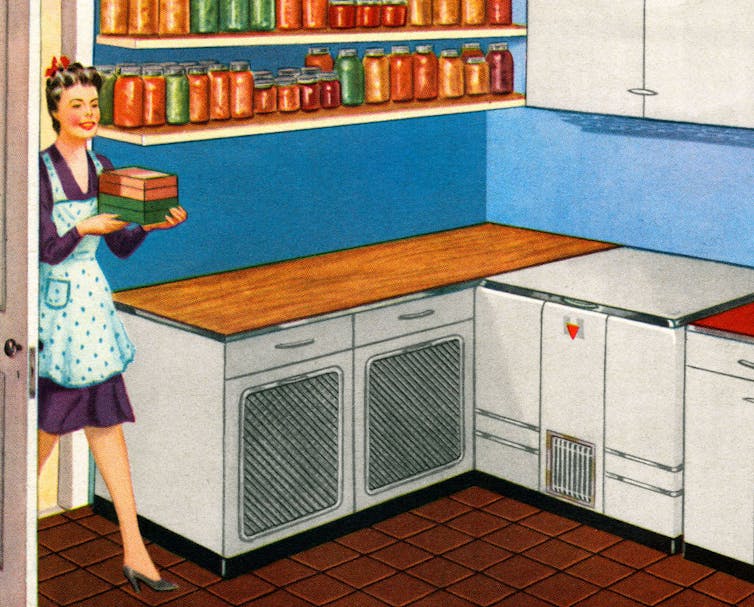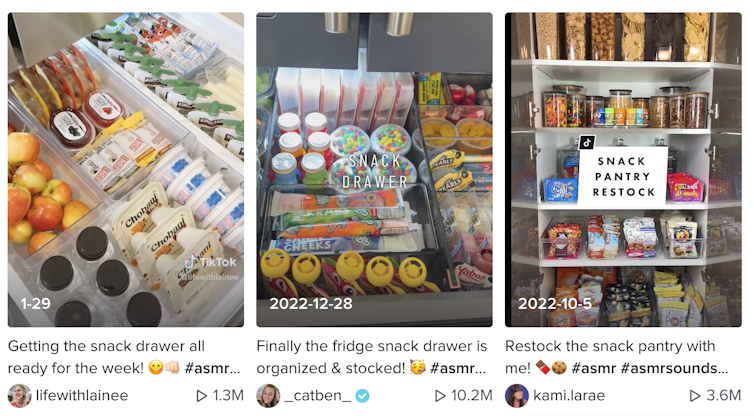THE CONVERSATION
Author Jenna Drenten
Associate Professor of Marketing,
Loyola University Chicago
Published: March 14, 2023
Neatly aligned glass spice jars tagged with printed white labels. Wicker baskets filled with packages of pasta, crackers and snacks. Rows of flavored seltzer water stacked in double-decker plastic bins.
In today’s consumer culture, “a place for everything and everything in its place” isn’t just a mantra; it’s big business. Nowhere is this more evident than the kitchen pantry.
Most people can relate to finding half-empty cereal boxes squirreled away in the cupboard or letting produce sit just a bit too long in a refrigerator drawer.
But for a subset of social media denizens, such sacrileges would never grace their feeds.
Get news that’s free, independent and based on evidence.Sign up for newsletter
As someone who studies digital consumer culture, I’ve noticed an uptick in glamorized, stylized and fully stocked pantries on TikTok and Instagram, giving rise to a content genre I dub “pantry porn.”
How did the perfectly organized pantry become so ubiquitous in the digital age? And what does it say about the expectations of being a good homemaker?
When pantries became pretty
The pantry – derived from the Latin word for bread, “panis” – was originally a hidden space for storing food. It was purely functional, not a place to show off to others. In the late 1800s, the butler’s pantry emerged as an architectural trend among high society. This small space, tucked between the kitchen and dining room, was a marker of status – an area to hide both the food and the people who prepared it.
Throughout the next century, pantries started being built in middle-class homes. As open floor plans became popular in the 1950s, kitchens emerged into plain view. This design shift paved the way for many modern American pantries to feature sweeping floor-to-ceiling, wall-to-wall cabinetry and walk-in storage spaces.
Neatly aligned glass spice jars tagged with printed white labels. Wicker baskets filled with packages of pasta, crackers and snacks. Rows of flavored seltzer water stacked in double-decker plastic bins.
In today’s consumer culture, “a place for everything and everything in its place” isn’t just a mantra; it’s big business. Nowhere is this more evident than the kitchen pantry.
Most people can relate to finding half-empty cereal boxes squirreled away in the cupboard or letting produce sit just a bit too long in a refrigerator drawer.
But for a subset of social media denizens, such sacrileges would never grace their feeds.
Get news that’s free, independent and based on evidence.Sign up for newsletter
As someone who studies digital consumer culture, I’ve noticed an uptick in glamorized, stylized and fully stocked pantries on TikTok and Instagram, giving rise to a content genre I dub “pantry porn.”
How did the perfectly organized pantry become so ubiquitous in the digital age? And what does it say about the expectations of being a good homemaker?
When pantries became pretty
The pantry – derived from the Latin word for bread, “panis” – was originally a hidden space for storing food. It was purely functional, not a place to show off to others. In the late 1800s, the butler’s pantry emerged as an architectural trend among high society. This small space, tucked between the kitchen and dining room, was a marker of status – an area to hide both the food and the people who prepared it.
Throughout the next century, pantries started being built in middle-class homes. As open floor plans became popular in the 1950s, kitchens emerged into plain view. This design shift paved the way for many modern American pantries to feature sweeping floor-to-ceiling, wall-to-wall cabinetry and walk-in storage spaces.

Bigger homes meant more space to store food.
GraphicaArtis/Hulton Archive via Getty Images.
Today, over 85% of new homes built in America that are over 3,500 square feet feature a walk-in pantry, reportedly the most desirable kitchen feature for new homebuyers, according to a 2019 report.
Celebrities can be credited – at least, in part – for making the pantry a modern-day status symbol. The Kardashian-Jenner family has long been an exemplar for #pantrygoals, and former “Real Housewives” star Yolanda Hadid has social media fan pages dedicated to her fridge.
In the digital age, social media influencers have stepped in as trickle-down tastemakers who translate symbols of celebrity culture into accessible markers of status for the rest of us.
Meticulously arranged pantries appeal to middle-class sensibilities: Maybe you can’t have a designer kitchen, but you can beautify your bulk food storage.
Today, over 85% of new homes built in America that are over 3,500 square feet feature a walk-in pantry, reportedly the most desirable kitchen feature for new homebuyers, according to a 2019 report.
Celebrities can be credited – at least, in part – for making the pantry a modern-day status symbol. The Kardashian-Jenner family has long been an exemplar for #pantrygoals, and former “Real Housewives” star Yolanda Hadid has social media fan pages dedicated to her fridge.
In the digital age, social media influencers have stepped in as trickle-down tastemakers who translate symbols of celebrity culture into accessible markers of status for the rest of us.
Meticulously arranged pantries appeal to middle-class sensibilities: Maybe you can’t have a designer kitchen, but you can beautify your bulk food storage.
Throughout the 2010s, food porn dominated social media. The so-called “camera eats first” phenomenon introduced user-generated images of cooking, eating and staging food.
Consumers’ controversial obsession with food photography resulted in some restaurants banning smartphone photography while other businesses created veritable wonderlands for food-inspired selfies such as the Museum of Ice Cream and The Egg House.
New technology did not invent food porn, but it did catalyze it in new ways. Consumers armed with camera phones could suddenly fetishize meals for the voyeuristic pleasure of their friends and followers. This dynamic of watching and being watched is a hallmark of modern digital consumer culture where nonsexual things are linguistically tethered to porn: food porn, travel porn, book porn, real estate porn. Coupling social media content with the “porn” descriptor acts as shorthand for desirability, gratification and gawking.
Pantry porn is a mashup of infotainment, how-to, lifestyle content and ASMR, a form of sound-driven content intended to relax viewers.
Influencers film themselves shopping for supplies, prepping food, refilling containers, and organizing their pantries – often coupled with hashtags like #pantryrestock, #pantryASMR, and #pantrygoals. They transfer dry goods from the store-bought bags into matching glassware; they stock the home coffee bar with coffee pods and flavored syrups; they refill stackable bins with single-serving snacks; they create multiple types of ice cubes – each with its own dedicated freezer section. Much of this pantry porn is performed against a backdrop of rhythmic ASMR-inspired clinks, glugs, snaps, rips and thunks that appeal to viewers’ pleasure centers.

Screenshots of snack drawer restock videos on TikTok. TikTok
Like its food porn predecessor, pantry porn thrives on stylizing everyday life in exaggerated ways. But where food porn elicits a desire for gluttonous indulgence, pantry porn taps into a different cultural desire: the orderly arrangement of abundance.
Excess is bad, but organized excess is good
The past decade has ushered in a home organizing revolution.
An entire cottage industry of blogs, books and television shows have introduced people to terms like “decluttering,” “minimalism” and “simple living.”
Minimalism once represented a countercultural lifestyle rooted in anti-consumption: Use less, buy less, have less.
But if pantry porn is any indication, the new minimalism means more is more, as long as the more is not messy. Consumers don’t need less, they need more: more containers, more labels, more storage space.
Storing spices in coordinated glass jars and color coordinating dozens of sprinkles containers may seem trivial. But tidiness is tangled up with status, and messiness is loaded with assumptions about personal responsibility and respectability.
Cleanliness has historically been used as a cultural gatekeeping mechanism to reinforce status distinctions based on a vague understanding of “niceness”: nice people, with nice yards, in nice houses, make for nice neighborhoods.
What lies beneath the surface of this anti-messiness, pro-niceness stance is a history of classist, racist and sexist social structures. In my research, influencers who produce pantry porn are predominantly white women who demonstrate what it looks like to maintain a “nice” home by creating a new status symbol: the perfectly organized, fully stocked pantry.
Perhaps it’s not surprising that pantry porn found its foothold during the COVID-19 pandemic, when shortages in the supply chain surged. Keeping stuff on hand became a symbol of resilience for those with the money and space to do so. This allure of strategic stockpiling is evident in other collector subcultures like doomsday preppers and extreme couponers.
Like its food porn predecessor, pantry porn thrives on stylizing everyday life in exaggerated ways. But where food porn elicits a desire for gluttonous indulgence, pantry porn taps into a different cultural desire: the orderly arrangement of abundance.
Excess is bad, but organized excess is good
The past decade has ushered in a home organizing revolution.
An entire cottage industry of blogs, books and television shows have introduced people to terms like “decluttering,” “minimalism” and “simple living.”
Minimalism once represented a countercultural lifestyle rooted in anti-consumption: Use less, buy less, have less.
But if pantry porn is any indication, the new minimalism means more is more, as long as the more is not messy. Consumers don’t need less, they need more: more containers, more labels, more storage space.
Storing spices in coordinated glass jars and color coordinating dozens of sprinkles containers may seem trivial. But tidiness is tangled up with status, and messiness is loaded with assumptions about personal responsibility and respectability.
Cleanliness has historically been used as a cultural gatekeeping mechanism to reinforce status distinctions based on a vague understanding of “niceness”: nice people, with nice yards, in nice houses, make for nice neighborhoods.
What lies beneath the surface of this anti-messiness, pro-niceness stance is a history of classist, racist and sexist social structures. In my research, influencers who produce pantry porn are predominantly white women who demonstrate what it looks like to maintain a “nice” home by creating a new status symbol: the perfectly organized, fully stocked pantry.
Perhaps it’s not surprising that pantry porn found its foothold during the COVID-19 pandemic, when shortages in the supply chain surged. Keeping stuff on hand became a symbol of resilience for those with the money and space to do so. This allure of strategic stockpiling is evident in other collector subcultures like doomsday preppers and extreme couponers.
The pressure of the perfect kitchen
The work required to restock, refill, and reset the kitchen is a central element in producing everyday pantry porn.
In my research, I’ve found that this work often falls to women in the household. One TikTok mom goes on a “snack strike,” stating she will not restock the pantry until her children and husband eat what they already have.
Magazines like Good Housekeeping were once the brokers of idealized domestic work. Now online pantry porn sets the aspirational standard for becoming an ideal mom, ideal wife and ideal woman. This grew out of a shift toward an intensive mothering ideology that equates being a good mom with time-intensive, labor-intensive, financially expensive care work.
Sure, all of those baskets and bins serve a functional purpose in the home: seeing what you need, when you need it. But the social pressure to curate a perfect pantry might make some women work overtime. They can’t just shove store-bought boxes of snacks into a cupboard; they must neatly place the grab-and-go snacks into a fully stocked pantry that rivals a boutique corner store.
Pantry porn, as a status symbol, relies on the promise of making daily domestic work easier. But if women are largely responsible for the work required to maintain the perfectly organized pantry, it’s critical to ask: easier for whom?

No comments:
Post a Comment